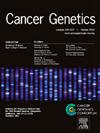TFAP2E acts as a tumor suppressor by regulating cell cycle progression in oral squamous cell carcinoma cells
IF 2.1
4区 医学
Q4 GENETICS & HEREDITY
引用次数: 0
Abstract
TFAP2E, a member of the activator protein-2 transcription factor family, is considered to act as a tumor suppressor. Lower TFAP2E expression is associated with poor prognosis in patients with different cancer types. TFAP2E gene is located on chromosome 1q34, where is commonly deleted region in the cancer genome. Our previous research indicated that TFAP2E suppresses cell growth by regulating cell cycle progression from the G2 to M phase. However, as the analyses were performed using asynchronized cells, other possibilities cannot be ruled out. The present study aimed to analyze the effects of TFAP2E silencing on synchronized cells. Human oral squamous cell carcinoma (OSCC)-derived Ca9–22 cells were stably transfected with TFAP2E-short hairpin RNA and synchronized to the late-G1 phase using double thymidine block. Cell cycle progression rate was analyzed by periodically examining cell cycle distribution patterns using fluorescence-activated cell sorting analysis. TFAP2E-knockdown cells showed a rapid exit from the M-phase compared with control cells; meanwhile, no difference was observed between the cells until the end of S-phase. Additionally, rapid M-phase exit was not observed in TFAP2E-knockdown cells following release from nocodazole-mediated synchronization to the G2/M-phase. These observations indicated that TFAP2E-knockdown results in rapid cell cycle progression from the G2 to M phase. Overall, current findings suggest that TFAP2E acts as a tumor suppressor by regulating cell cycle progression at least in OSCC cells.
TFAP2E通过调节口腔鳞状细胞癌细胞周期进程发挥抑瘤作用
TFAP2E是激活蛋白-2转录因子家族的成员,被认为具有肿瘤抑制作用。TFAP2E低表达与不同癌症类型患者预后不良相关。TFAP2E基因位于染色体1q34上,这是癌症基因组中常见的缺失区域。我们之前的研究表明,TFAP2E通过调节细胞周期从G2期到M期的进程来抑制细胞生长。然而,由于分析是使用异步单元执行的,因此不能排除其他可能性。本研究旨在分析TFAP2E沉默对同步细胞的影响。用tfap2e短发夹RNA稳定转染人口腔鳞状细胞癌(OSCC)来源的Ca9-22细胞,并使用双胸腺嘧啶阻断使其同步到g1晚期。通过荧光活化细胞分选分析定期检查细胞周期分布模式来分析细胞周期进展率。与对照细胞相比,tfap2e敲低细胞能快速退出m期;同时,直到s期结束,细胞间均无差异。此外,在tfap2e敲低的细胞中,从诺可达唑介导的同步释放到G2/ m期后,没有观察到快速退出m期。这些观察结果表明,tfap2e敲低导致细胞周期从G2期快速进展到M期。总的来说,目前的研究结果表明,至少在OSCC细胞中,TFAP2E通过调节细胞周期进程发挥肿瘤抑制作用。
本文章由计算机程序翻译,如有差异,请以英文原文为准。
求助全文
约1分钟内获得全文
求助全文
来源期刊

Cancer Genetics
ONCOLOGY-GENETICS & HEREDITY
CiteScore
3.20
自引率
5.30%
发文量
167
审稿时长
27 days
期刊介绍:
The aim of Cancer Genetics is to publish high quality scientific papers on the cellular, genetic and molecular aspects of cancer, including cancer predisposition and clinical diagnostic applications. Specific areas of interest include descriptions of new chromosomal, molecular or epigenetic alterations in benign and malignant diseases; novel laboratory approaches for identification and characterization of chromosomal rearrangements or genomic alterations in cancer cells; correlation of genetic changes with pathology and clinical presentation; and the molecular genetics of cancer predisposition. To reach a basic science and clinical multidisciplinary audience, we welcome original full-length articles, reviews, meeting summaries, brief reports, and letters to the editor.
 求助内容:
求助内容: 应助结果提醒方式:
应助结果提醒方式:


